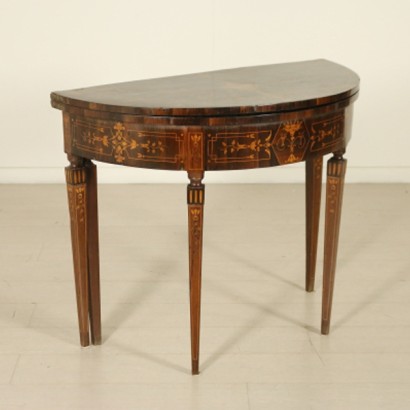Demilune game table
Features
Style: Neo-Classical (1765-1790)
Age: 18th Century / 1701 - 1800
Origin: Emilia Romagna, Italy
Main essence: Rosewood
Material: Rosewood Slab
Description
Demilune game table features legs with fluted trunk-inlaid and pyramidal wall Endcap. Fifth leg opening hinged to allow the support of the plan. On the plane and on the refined floral inlays and typical Emilian amphora. Secret drawer missing. Floor g/fold sleeve with leather insert.
Product Condition:
Requires small restoration and resumption of polishing.
Dimensions (cm):
Height: 76
Width: 94
Depth: 47,5
Diameter: 96
Additional Information
Style: Neo-Classical (1765-1790)
This historical period includes a first phase that can be properly defined as the Louis XVI style.nOnly at a later time, with the maturation of archaeological fashions, was a new vision of furnishing civilization formulated and codified, now fully attributable to the Neoclassical Style.
In fact, both trends coexisted in unison until the last years of the eighteenth century.
nIn the field of cabinet making, the Directoire, Retour d'Egypte, Consular and Empire styles also fall within the neoclassical era.
nFind out more about Neoclassicism with the insights from our blog...
n



























